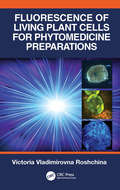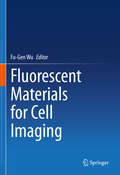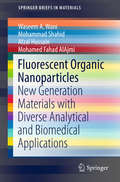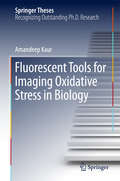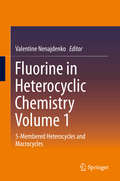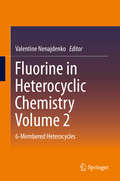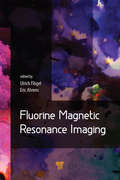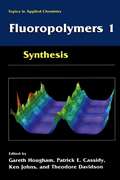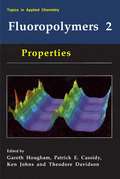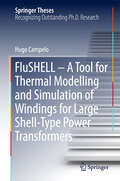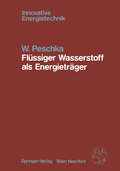- Table View
- List View
Fluorescence of Living Plant Cells for Phytomedicine Preparations
by Victoria Vladimirovna RoshchinaFluorescence of Living Plant Cells for Phytomedicine Preparations reveals how valuable medicinal compounds can be identified through the application of vital fluorescence in plant cells. The book explains the roles that fluorescent compounds play in plant physiology and promotes our knowledge of plant secretory cells and phytopreparations. Supported by vivid illustrations, the book reveals how actinic light – light that induces fluorescence in leaves and flowers – can be used in the identification of secretory cells within plant tissue that may be the repository of valuable medicinal compounds. The book demonstrates the potential of fluorescence in pharmacological analysis with detailed methods for applying fluorescence to identify these deposits of natural drugs. As such, this groundbreaking book contains methods of express-pharmaceutical analysis that could open new horizons in pharmacy and the cultivation of medicinal plants. Features Describes various fluorescence microscopy techniques for the localization of compounds contained in plants with pharmaceutical interest Provides an analysis of pharmaceutical material based on autofluorescence and histochemical reactions for numerous medicinal plant species Demonstrates practices for providing optimal growing conditions and improving the quality of the compounds Showing the readiness of plant raw material for pharmaceutical industry, this book will appeal to professionals in the pharmaceutical industry and students and researchers in the fields of phytochemistry, botany and pharmaceutical sciences.
Fluorescence of Supermolecules, Polymers, and Nanosystems (Springer Series on Fluorescence #4)
by Mario N. Berberan-SantosThis, the fourth volume in the Springer series on fluorescence, focuses on the fluorescence of nanosystems, polymers and supermolecules, as well as the development and application of fluorescent probes. Aimed at researchers in organic and physical chemistry and in material sciences, emphasis is placed on the fluorescence of artificial and biological nanosystems; single molecule fluorescence and the luminescence of polymers; and micro- and nanoparticles and nanotubes.
Fluorescence Spectroscopy and Microscopy in Biology (Springer Series on Fluorescence #20)
by Radek Šachl Mariana AmaroThis book provides the reader with an updated comprehensive view of the rapidly developing and fascinating field of fluorescence spectroscopy and microscopy. In recent years, fluorescence spectroscopy and microscopy have experienced rapid technological development, which has enabled the detection and monitoring of single molecules with high spatial and temporal resolution. Thanks to these developments, fluorescence has become an even more popular method in physical, biological and related fields. This book guides the reader through both basic and advanced fluorescence spectroscopy and microscopy approaches with a focus on their applications in membrane and protein biophysics. Each of the four parts: A - Fluorescence Spectroscopy, B - Fluorescence Microscopy, C - Applications of Fluorescence Spectroscopy and Microscopy to biological membranes and D - Applications of Fluorescence Spectroscopy to protein studies are written by experts within the field. The book isintended for both complete beginners who want to quickly orient themselves in the large number of existing fluorescent methods, as well as for advanced readers who are interested in particular methods and their proper use. Chapter “Dynamics and Hydration of Proteins Viewed by Fluorescence Methods: Investigations for Protein Engineering and Synthetic Biology” is available open access under a Creative Commons Attribution 4.0 International License via link.springer.com.
Fluorescence Spectroscopy, Imaging and Probes: New Tools in Chemical, Physical and Life Sciences (Springer Series on Fluorescence #2)
by Ruud Kraayenhof Antonie J. W. G. Visser Hans C. GerritsenThe increased use of fluorescence techniques is greatly enhanced by the improved instrumentation pioneered by inventive scientists and now made available commercially by several high-tech companies. Moreover, the design and development of many new molecular probes with higher selectivity for specific microenvironmental properties has stimulated many new researchers to employ fluorescence techniques for solving their problems. This topic book, the second in his series, reflects this exciting scientific progress and deals, among others, with new approaches and new probes in fluorescence spectroscopy, single molecule fluorescence, applications in biomembrane and enzyme studies and imaging of living cells.
Fluorescence Studies of Polymer Containing Systems (Springer Series on Fluorescence #16)
by Karel ProcházkaThis volume describes the application of fluorescence spectroscopy in polymer research. The first chapters outline the basic principles of the conformational and dynamic behavior of polymers and review the problems of polymer self-assembly. Subsequent chapters introduce the theoretical principles of advanced fluorescence methods and typical examples of their application in polymer science. The book closes with several reviews of various fluorescence applications for studying specific aspects of polymer-solution behavior. It is a useful resource for polymer scientists and experts in fluorescence spectroscopy alike, facilitating their communication and cooperation.
Fluorescent Imaging in Medicinal Chemistry (Topics in Medicinal Chemistry #34)
by Zhen ChengThis book reviews the most recent developments of fluorescent imaging techniques for medicinal chemistry research and biomedical applications, including cell imaging, in vitro diagnosis and in vivo imaging. Fluorescent imaging techniques play an important role in basic research, drug discovery and clinical translation. They have great impact to many fields including chemical biology, cell biology, medical imaging, cancer diagnosis and treatment, pharmaceutical science, among others, and they have facilitated our understanding of diseases and helped to develop many novel powerful tools for imaging and treatment of diseases. This book will appeal to scientists from numerous fields such as chemistry, pharmaceutical science, biology, materials science, and medicine, and it will serve as a very useful and handy resource for readers with different levels of scientific knowledge, ranging from entry level to professional level.
Fluorescent Materials for Cell Imaging
by Fu-Gen WuThis book focuses on the latest fluorescent materials for cell imaging. Cell imaging is a widely used basic technique that helps scientists gain a better understanding of biological functions through studies of cellular structure and dynamics. In the past decades, the development of a variety of new fluorescent materials has significantly extended the applications of cellular imaging techniques. This book presents recently developed fluorescent materials, including semiconductor quantum dots, carbon dots, silicon nanoparticles, metal nanoclusters, upconversion nanoparticles, conjugated polymers/polymer dots, aggregation-induced emission (AIE) probes, and coordination compounds, used for various cellular imaging purposes. It will appeal to cell biologists and other researchers in academia, industry and clinical settings who are interested in the technical development and advanced applications of fluorescence imaging in cells, tissues and organisms to explore the mechanisms of biological functions and diseases.
Fluorescent Microscopy (Methods in Molecular Biology #2440)
by Bryan HeitThis volume provides both experienced and new microscopists with methods and protocols to perform fluorescence microscopy-based experiments. The book is divided into four parts detailing basic fluorescent microscopy, quantitative methods, imaging living animals, human tissue samples, approaches for imaging at a near-molecular level, and approaches to image analysis. Written in the format of the highly successful Methods in Molecular Biology series, each chapter includes an introduction to the topic, lists necessary materials and reagents, includes tips on troubleshooting and known pitfalls, and step-by-step, readily reproducible protocols. Authoritative and cutting-edge, Fluorescent Microscopy aims to be a useful practical guide to researches to help further their study in this field.
Fluorescent Organic Nanoparticles: New Generation Materials with Diverse Analytical and Biomedical Applications (SpringerBriefs in Materials)
by Waseem A. Wani Mohammad Shahid Afzal Hussain Mohamed Fahad AlAjmiThis book provides a critical review of recent advances in the development of fluorescent organic nanoparticles as materials of choice for the design and fabrication of sensors, bioimaging agents and drug delivery systems. The properties and functions of nanoparticles differ significantly from those of their parent entities or their bulk phases. Two of their most important features are their increased surface-to volume ratio, and the formation of surface structures differing from those in their bulk phases. In addition, the book discusses the synthesis of fluorescent conjugated polymers, self-assembled fluorescent nanoparticles, polydopamine nanoparticles, and aggregation-induced-emission or aggregation-induced-emission enhancement nanomaterials. In closing, the book provides an outlook on future research and development in fluorescent organic nanoparticles as smart materials with an impressive range of potential applications.
Fluorescent Tools for Imaging Oxidative Stress in Biology (Springer Theses)
by Amandeep KaurThis thesis advances the long-standing challenge of measuring oxidative stress and deciphering its underlying mechanisms, and also outlines the advantages and limitations of existing design strategies. It presents a range of approaches for the chemical synthesis of fluorescent probes that detect reversible changes in cellular oxidative stress. The ability to visualise cellular processes in real-time is crucial to understanding disease development and streamline treatment, and this can be achieved using fluorescent tools that can sense reversible disturbances in cellular environments during pathogenesis. The perturbations in cellular redox state are of particular current interest in medical research, since oxidative stress is implicated in the pathogenesis of a number of diseases.The book investigates different strategies used to achieve ratiometric fluorescence output of the reversible redox probes, which nullify concentration effects associated with intensity-based probes. It also describes suitable approaches to target these probes to specific cellular organelles, thereby enabling medical researchers to visualise sub-cellular oxidative stress levels, and addressing the typically poor uptake of chemical tools into biological studies. In total it reports on four new probes that are now being used by over twenty research groups around the globe, and two of which have been commercialised. The final chapters of this thesis demonstrate successful applications of the sensors in a variety of biological systems ranging from prokaryotes to mammalian cells and whole organisms. The results described clearly indicate the immense value of collaborative, cross-disciplinary research.
Fluoride in Drinking Water: Status, Issues, and Solutions
by A.K. Gupta S. AyoobExplore the Health Effects of Fluoride PollutionFluoride in Drinking Water: Status, Issues, and Solutions establishes the negative impacts of naturally occurring fluoride on human health and considers the depth and scope of fluoride pollution on an international scale. The book discusses current global water quality and fluoride-related issues and
Fluoride Removal from Groundwater by Adsorption Technology (IHE Delft PhD Thesis Series)
by Abdulai SalifuIn the Eastern corridor of Northern region of Ghana, presence of high fluoride concentration in the groundwater has made many drilled boreholes unusable for drinking. Little is, however, known about the factors contributing to the occurrence of high fluoride in this part of Ghana and it’s spatial distribution. Treatment of the fluoride-contaminated groundwater by adsorption is also hampered by the lack of suitable adsorbents that are locally available. Based on principal component analysis, and saturation indices calculations, this thesis highlights that, the predominant mechanisms controlling the fluoride enrichment probably include calcite precipitation and Na/Ca exchange processes, both of which deplete Ca from the groundwater, and promote the dissolution of fluorite. The mechanisms also include F-/OH- anion exchange processes, as well as evapotranspiration processes which concentrate the fluoride ions, hence increasing its concentration in the groundwater. Spatial mapping showed that the high fluoride groundwaters occur predominantly in the Saboba, Cheriponi and Yendi districts. The thesis further highlights that, modifying the surface of indigenous materials by an aluminium coating process, is a very promising approach to develop a suitable fluoride adsorbent. Aluminum oxide coated media reduced fluoride in water from 5. 0 ± 0.2 mg/L to ≤ 1.5 mg/L (which is the WHO health based guideline for fluoride), in both batch and continuous flow column experiments in the laboratory. Kinetic and isotherm studies, thermodynamic calculations, as well as analytical results from Fourier Transform Infrared Spectroscopy and Raman spectroscopy, suggest the mechanism of fluoride adsorption onto aluminium oxide coated media involved both physisorption and chemisorption processes. Field testing in a fluoritic community in Northern Ghana showed that the adsorbent is also capable of treating fluoride-contaminated groundwater in field conditions, suggesting it is a promising defluoridation adsorbent. The adsorbent also showed good regenerability potential that would allow re-use, which could make it practically and economically viable. Additional research is, however, required to further increase the fluoride adsorption capacity of developed adsorbent.
Fluoride Removal from Groundwater by Adsorption Technology (IHE Delft PhD Thesis Series)
by Abdulai SalifuIn the Eastern corridor of Northern region of Ghana, presence of high fluoride concentration in the groundwater has made many drilled boreholes unusable for drinking. Little is, however, known about the factors contributing to the occurrence of high fluoride in this part of Ghana and it’s spatial distribution. Treatment of the fluoride-contaminated groundwater by adsorption is also hampered by the lack of suitable adsorbents that are locally available. Based on principal component analysis, and saturation indices calculations, this thesis highlights that, the predominant mechanisms controlling the fluoride enrichment probably include calcite precipitation and Na/Ca exchange processes, both of which deplete Ca from the groundwater, and promote the dissolution of fluorite. The mechanisms also include F-/OH- anion exchange processes, as well as evapotranspiration processes which concentrate the fluoride ions, hence increasing its concentration in the groundwater. Spatial mapping showed that the high fluoride groundwaters occur predominantly in the Saboba, Cheriponi and Yendi districts. The thesis further highlights that, modifying the surface of indigenous materials by an aluminium coating process, is a very promising approach to develop a suitable fluoride adsorbent. Aluminum oxide coated media reduced fluoride in water from 5. 0 ± 0.2 mg/L to ≤ 1.5 mg/L (which is the WHO health based guideline for fluoride), in both batch and continuous flow column experiments in the laboratory. Kinetic and isotherm studies, thermodynamic calculations, as well as analytical results from Fourier Transform Infrared Spectroscopy and Raman spectroscopy, suggest the mechanism of fluoride adsorption onto aluminium oxide coated media involved both physisorption and chemisorption processes. Field testing in a fluoritic community in Northern Ghana showed that the adsorbent is also capable of treating fluoride-contaminated groundwater in field conditions, suggesting it is a promising defluoridation adsorbent. The adsorbent also showed good regenerability potential that would allow re-use, which could make it practically and economically viable. Additional research is, however, required to further increase the fluoride adsorption capacity of developed adsorbent.
Fluorine in Heterocyclic Chemistry Volume 1: 5-Membered Heterocycles and Macrocycles
by Valentine NenajdenkoThis two-volume work combines comprehensive information on the chemistry of the fluorinated heterocycles. The material has been divided such that the first volume is dedicated to 5-membered fluorinated heterocycles and macrocycles, while the second volume combines data connected with the chemistry of fluorine containing 6-membered heterocycles. Both volumes will be of interest to synthetic organic chemists in general, and particularly for those colleagues working in the fields of heterocyclic-compound chemistry, materials chemistry, medicinal chemistry, and fluorine chemistry. All information is presented and classified clearly to be effective source for broad auditory of chemists. It will be interesting for scientists working in the field of inorganic and coordination chemistry. Fluorinated heterocycles are becoming increasingly important in many areas including the pharmaceutical industry, materials science and agriculture. The presence of fluorine can result in substantial functional changes in the biological as well as physicochemical properties of organic compounds. Incorporation of fluorine into drug molecules can greatly affect their physicochemical properties, such as bond strength, lipophilicity, bioavailability, conformation, electrostatic potential, dipole moment, pKa etc. as well as pharmacokinetic properties, such as tissue distribution, rate of metabolism and pharmacological properties, such as pharmacodynamics and toxicology.
Fluorine in Heterocyclic Chemistry Volume 2: 6-Membered Heterocycles
by Valentine NenajdenkoThis two-volume work combines comprehensive information on the chemistry of the fluorinated heterocycles. The material has been divided such that the first volume is dedicated to 5-membered fluorinated heterocycles and macrocycles, while the second volume combines data connected with the chemistry of fluorine containing 6-membered heterocycles. Both volumes will be of interest to synthetic organic chemists in general, and particularly for those colleagues working in the fields of heterocyclic-compound chemistry, materials chemistry, medicinal chemistry, and fluorine chemistry. All information is presented and classified clearly to be effective source for broad auditory of chemists. It will be interesting for scientists working in the field of inorganic and coordination chemistry. Fluorinated heterocycles are becoming increasingly important in many areas including the pharmaceutical industry, materials science and agriculture. The presence of fluorine can result in substantial functional changes in the biological as well as physicochemical properties of organic compounds. Incorporation of fluorine into drug molecules can greatly affect their physicochemical properties, such as bond strength, lipophilicity, bioavailability, conformation, electrostatic potential, dipole moment, pKa etc. as well as pharmacokinetic properties, such as tissue distribution, rate of metabolism and pharmacological properties, such as pharmacodynamics and toxicology.
Fluorine Magnetic Resonance Imaging
by Ulrich Flögel Eric AhrensOver the past decade, fluorine (19F) magnetic resonance imaging (MRI) has garnered significant scientific interest in the biomedical research community owing to the unique properties of fluorinated materials and the 19F nucleus. Fluorine has an intrinsically sensitive nucleus for MRI. There is negligible endogenous 19F in the body and thus there is no background signal. Fluorine-containing compounds are ideal tracer labels for a wide variety of MRI applications. Moreover, the chemical shift and nuclear relaxation rate can be made responsive to physiology via creative molecular design. This book is an interdisciplinary compendium that details cutting-edge science and medical research in the emerging field of 19F MRI. Edited by Ulrich Flögel and Eric Ahrens, two prominent MRI researchers, this book will appeal to investigators involved in MRI, biomedicine, immunology, pharmacology, probe chemistry, and imaging physics.
Fluorine Magnetic Resonance Imaging
by Ulrich Flogel Eric AhrensOver the past decade, fluorine (19F) magnetic resonance imaging (MRI) has garnered significant scientific interest in the biomedical research community owing to the unique properties of fluorinated materials and the 19F nucleus. Fluorine has an intrinsically sensitive nucleus for MRI. There is negligible endogenous 19F in the body and thus there is no background signal. Fluorine-containing compounds are ideal tracer labels for a wide variety of MRI applications. Moreover, the chemical shift and nuclear relaxation rate can be made responsive to physiology via creative molecular design. This book is an interdisciplinary compendium that details cutting-edge science and medical research in the emerging field of 19F MRI. Edited by Ulrich Flögel and Eric Ahrens, two prominent MRI researchers, this book will appeal to investigators involved in MRI, biomedicine, immunology, pharmacology, probe chemistry, and imaging physics.
Fluoropolymers 1: Synthesis (Topics in Applied Chemistry)
by Patrick E. Cassidy Theodore Davidson Ken Johns Gareth G. HoughamThe fluorine atom, by virtue of its electronegativity, size, and bond strength with carbon, can be used to create compounds with remarkable properties. Small molecules containing fluorine have many positive impacts on everyday life of which blood substitutes, pharmaceuticals, and surface modifiers are only a few examples. Fluoropolymers, too, while traditionally associated with extreme hi- performance applications have found their way into our homes, our clothing, and even our language. A recent American president was often likened to the tribology of PTFE. Since the serendipitous discovery of Teflon at the Dupont Jackson Laboratory in 1938, fluoropolymers have grown steadily in technological and marketplace importance. New synthetic fluorine chemistry, new processes, and new apprec- tion of the mechanisms by which fluorine imparts exceptional properties all contribute to accelerating growth in fluoropolymers. There are many stories of harrowing close calls in the fluorine chemistry lab, especially from the early years, and synthetic challenges at times remain daunting. But, fortunately, modern techniques and facilities have enabled significant strides toward taming both the hazards and synthetic uncertainties. In contrast to past environmental problems associated with fluorocarbon refrigerants, the exceptional properties of fluorine in polymers have great environmental value. Some fluoropolymers are enabling green technologies such as hydrogen fuel cells for automobiles and oxygen-selective membranes for cleaner diesel combustion.
Fluoropolymers 2: Properties (Topics in Applied Chemistry)
by Gareth Hougham Patrick E. Cassidy Theodore Davidson Ken JohnsThe fluorine atom, by virtue of its electronegativity, size, and bond strength with carbon, can be used to create compounds with remarkable properties. Small molecules containing fluorine have many positive impacts on everyday life of which blood substitutes, pharmaceuticals, and surface modifiers are only a few examples. Fluoropolymers, too, while traditionally associated with extreme high performance applications have found their way into our homes, our clothing, and even our language. A recent American president was often likened to the tribology of PTFE. Since the serendipitous discovery of Teflon at the DuPont Jackson Laboratory in 1938, fluoropolymers have grown steadily in technological and marketplace importance. New synthetic fluorine chemistry, new processes, and new apprecia tion of the mechanisms by which fluorine imparts exceptional properties all contribute to accelerating growth in fluoropolymers. There are many stories of harrowing close calls in the fluorine chemistry lab, especially from the early years, and synthetic challenges at times remain daunting. But, fortunately, modem techniques and facilities have enabled significant strides toward taming both the hazards and synthetic uncertainties, In contrast to past environmental problems associated with fluorocarbon refrigerants, the exceptional properties of fluorine in polymers have great environmental value. Some fluoropolymers are enabling green technologies such as hydrogen fuel cells for automobiles and oxygen selective membranes for cleaner diesel combustion.
FluSHELL – A Tool for Thermal Modelling and Simulation of Windings for Large Shell-Type Power Transformers (Springer Theses)
by Hugo CampeloThis thesis addresses a novel application of network modelling methodologies to power transformers. It develops a novel thermal model and compares its performance against that of a commercial computational fluid dynamics (CFD) code, as well as in experiments conducted in a dedicated setup built exclusively for this purpose. Hence, the thesis cross-links three of the most important aspects in high-quality research: model development, simulation and experimental validation.Network modelling is used to develop a tool to simulate the thermal performance of power transformers, widely acknowledged to be critical assets in electrical networks. After the strong de-regulation of electricity markets and de-carbonization of worldwide economies, electrical networks have been changing fast. Both asset owners and equipment manufacturers are being driven to develop increasingly accurate modelling capabilities in order to optimize either their operation or their design. Temperature is a critical parameter in every electric machine and power transformers are no exception. As such, the thesis is relevant for a wide range of stakeholders, from utilities to power transformer manufacturers, as well as researchers interested in the energy industry. It is written in straightforward language and employs a highly pedagogic approach, making it also suitable for non-experts.
Flussaltwässer: Ökologie und Sanierung
by Volker Lüderitz Uta Langheinrich Christian KunzAuenaltwässer sind in Mitteleuropa vom Verschwinden bedrohte Ökosysteme. Deshalb sind in den letzten Jahren vor allem an der Elbe Maßnahmen zu ihrer Revitalisierung durchgeführt worden. Allerdings erfolgten diese Maßnahmen oft ohne eine gründliche wissenschaftliche Vor- und Nachbereitung. Das vorliegende Buch stellt auf Grundlage einer detaillierten Beschreibung der Genese und Ökologie von Altwässern eine leitbildorientierte Sanierungsstrategie vor und erläutert diese anhand von Beispielen. Neben den ökologischen und technischen werden auch rechtliche und finanzielle Aspekte behandelt.
